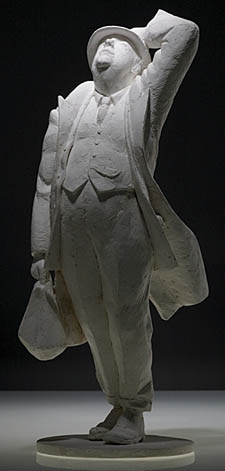|
|
 |
| |

Martin Jennings’ sculpture of Sir John Betjeman will greet passengers to St Pancras International, and blend with the station’s carvings and stonework from an earlier era |
A poet’s vision
It is difficult to imagine it now, but St Pancras station was very nearly wiped off the map altogether. The emblematic towers would be nothing more than a sad, distant memory, the name reminiscent of a historical marvel gone to seed, were it not for the strident campaigning of one man – Sir John Betjeman
THE much-loved Poet Laureate had two great passions – railways and Victorian architecture – and in St Pancras he found a perfect marriage. The station was the site of not one but two remarkable feats of engineering: the 19th-century neo-Gothic masterpiece St Pancras Chambers, formerly The Midland Grand Hotel, and William Henry Barlow’s gigantic train shed, with the largest ironwork span of any structure of its time.
But in 1962, with the concepts of “modernisation” and “urban renewal” heavy in the air, both structures were under threat. George Gilbert Scott’s fairy- tale redbrick was deemed derivative by contemporary architects while the Thames-Clyde Express, once the jewel in the station’s crown, had grown sluggish and outmoded.
The 300-room Midland Grand, at one point the finest hotel in the land, had closed its doors in 1935, never to reopen. Even the sheen of anoraks failed to catch the eye, as trainspotters deserted the station in favour of King’s Cross – its younger, busier neighbour.
Richard Beeching, chairman of British Railways commonly known as Doctor Beeching, proposed to divert all trains away from St Pancras and convert it into a sportsdome; others suggested office blocks in its stead.
Betjeman, a tireless conservationist, was appalled by such talk. The station was unique, he argued, and destroying it “would mean a loss of visual richness and excitement” tantamount to a criminal act.
He believed the personality of the station was so strong that it overshadowed the church and town hall of the same name in the mind of any Londoner, the mere mention of its name conjuring up lofty images of awe-inspiring architecture: “What he sees in his mind’s eye is that cluster of towers and pinnacles seen from Pentonville Hill and outlined against a foggy sunset, and the great arc of Barlow’s train shed gaping to devour incoming engines, and the sudden burst of exuberant Gothic of the hotel seen from gloomy Judd Street.”
His handsome words fell on deaf ears. The poet was mocked for his sentimentality and dismissed as a lone voice within the establishment, tainted by an unsuccessful campaign to save the Euston Arch some years earlier.
Even Sir John Summerson, an old friend of Betjeman’s and curator of Sir John Soane’s Museum, sided against him, saying he found Scott’s design both nauseating and unworthy of special protection.
Others found it a harsh reminder of Victorian austerity, or of a type “too recent to revere and too numerous to cherish”.
In his recent book St Pancras Station, the historian Simon Bradley ponders the reasons behind this public lack of enthusiasm. “A vague idea still circulates,” he writes, “that [St Pancras] had simply become out of its time, an enchanted Pre-Raphaelite castle stranded among Odeons and streamliners.”
Betjeman himself had gloomily prophesied the station’s destruction, describing it as “too beautiful and too romantic to survive” shortly after the Second World War.
Although the demolition of St Pancras had only been mentioned in vague threats and off-hand possibilities, it provoked such a flurry of debate, most notably in the letters columns of The Times throughout 1966, that in 1967 a decision was reached.
The change of fortunes came on November 2, 1967, when St Pancras was added to the national list of protected buildings at Grade I, joining the illustrious ranks of the Palace of Westminster and Canterbury Cathedral. It was just 10 days before the station’s date with the wrecking ball.
Yet, following the campaign, the toast of Victorian Britain’s railways still declined regardless. British Rail diverted all its trains except those to the East Midlands; the famous clock was smashed to smithereens by careless workmen as they removed it for sale; the once-grand concourse became the haunt of drug dealers and prostitutes.
But now, 23 years after his death and 40 years on from his campaign to save St Pancras, Betjeman’s message and his implacable faith in a public desire to preserve a national treasure have finally come to fruit. Brushed, buffed, spruced and polished by London and Continental Railways in an £800 million revamp, the glistening St Pancras International boasts a five-star hotel, luxury flats, 60 million bricks, 18,000 panes of self-cleaning glass and 300,000 Welsh slates.
Nor has the poet’s contribution been forgotten. In the entrance hall of the new Eurostar terminus, visitors to St Pancras will be greeted by a statue of Betjeman raising his trilby outside a gastropub bearing his name, looking up at the breathtaking roof of Barlow’s train shed, encouraging everyone to savour it as much as he did.
SIMON WROE
> Click here to buy your copy. |
|
 |
|
|
 |
|
 |
|








